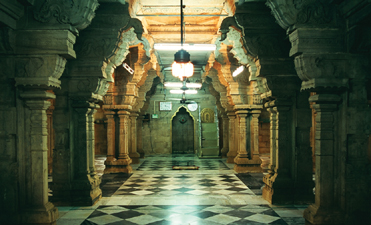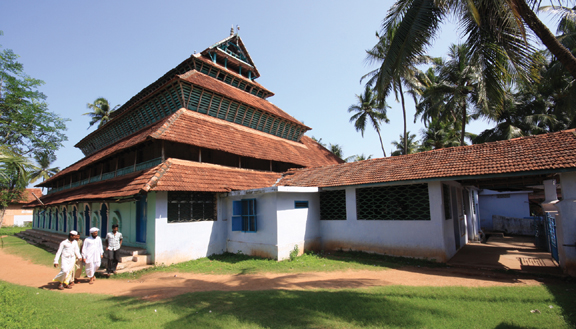
Kilakkarai Jumma Palli is one of the finest Dravidian style mosques. It was built by Seethakathi
Maraikayar in Kilakarai in the late 17th Century.
Kombai S. Anwar’s Yaadhum, a documentary recently screened, is, he says, his search for his Tamil Muslim identity, a who-am-I tour. At the end of the search for truth, there is always a revelation. So it was with the audience if the interaction at the end of the film was any indication.
All of us want to belong, and we know, at a deep instinctive level, that we “belong” at home, the first and basic social unit that we get to know. This need expands to the neighbourhood, community, society, and our country. There was a time when a Tamil poet sang that “all the world is mine and all are my family,” and Anwar picks his title from here, because today we have degenerated into different circles of “Us” and “Them”. In his search for himself, he discovers the connect and shares his discovery with us.
We too drive in the car with Anwar in his search for Tamil Muslim history in Calicut and in Kayalpattinam, in Pulicat and in Madurai, in Alwarthirunagari and in Keezhkattalai. Anwar strokes with wonder the carvings on the Big Temple, Thanjavur, moved by the thought that he is a part of the same civilisation. He plunges into the joyous bustle of Madurai, the city that never sleeps, with its colourful street dancers, the fragrant rows of jasmine sellers (Madurai Malli which got its G.I. recently) and the strains of the nadaswaram and takes us with him,

The Miskal Palli (mosque) built in the 14th Century in Calicut in the architectural tradition of
Kerala.
We enter the pallivasals (as Tamil Muslims call their mosques) with their pillars based on local architectural tradition. In one pallivasal the woodwork in green and gold in the centre is breathtaking. Islam has nothing akin to the Agamas that dictate how a temple shall be built, and so, in China, an 8th Century mosque blends with the local architectural landscape and in Africa and here too. Prof. M.G.S. Narayanan, an acclaimed historian and former Chairman of the Indian Council for Historical Research, tells us that in the Malabar region you cannot distinguish between Muslim and Hindu places of worship or residence, as both have used the same architecural style.
Once inside the pallivasal, we hear the songs from the Mirhaj Malai and Seerapuranam in traditional ragams like ‘Kapi’ and ‘Bageshri’. The singer, Seera Aboobakker, is wonderful. Yes, the two faiths are like rivers flowing side by side, as the opening shots establish. Sri Ranganatha on the Garuda is carried in procession along the streets of Kombai at a mosque and then the evening prayers commence in the pallivasal standing there.
It all started more than 2500 years ago with the pepper trade which connected the arid deserts of West Asia to the verdant slopes of the Western Ghats. The ships on the Spice Route brought the message of Islam to India in the 7th Century CE, and it took root. The kings of South India showed their munificence to Islamic places of worship as the Cheraman Jumma Pallivasal is testimony to.
The kings of South India, the Cheras, Cholas and the Pandyas, as well as the Naiks, like Achyutappa, and the Ramnad Sethupathis have held the Muslims in high esteem. One of the oldest pallivasals in Kodungallur is the Cheraman Jumma Palli. The land on which the dargah in Nagore stands was endowed by Achyutappa Naik. The Zamorin of Calicut trusted his Muslim sailors who served in his navy to protect his kingdom from the Portuguese. The navy was solely manned by them (as the Hindus were generally reluctant towards sea-travel), and to strengthen the navy the Zamorin is said to have decreed that at least one member from each fisherman’s family in Calicut had to embrace Islam. Kunjali Marakkayar was warrior non-pareil. We see inscriptions referring to ‘Sonagarn’ used mainly to refer to Muslims and also ‘Anjuvannam,’ a term used for West Asian Trade Guilds all along the coast of Tamizhagam. In Pulicat, a scholar reads to us from a historical record in Tamil written in Arabic script. The film also points to the Anaimangalam copper plate of the great Rajendra Chola which records the grant of land for the building of a Buddha Vihara. One of the signatories to this royal order is Turukkan Ahamed. There is a bass relief at the Alwarthirunagari temple showing a ship carrying a horse, obviously from Arabia.
In Muziris the excavations show the various influences that flowed in to India, and Dr. P.J. Cherian, Director, Kerala Council for Historical Research, says that trading does not bring in goods alone but ideas, technology, traditions and so on. And when these influences have flowed in and blended, how does one separate them into individual strands?
Culture is one of these poorly understood words in the English language. Culture is not monolithic. My culture is not a single-sided culture; I speak Tamil and, therefore, there is the Tamil culture; I profess a certain faith; and I am a woman, and so on. Each of them contributes to what shapes my cullture. Therefore, it would be difficult to say that my culture is static and one-sided. It is not easily definable. It conveys a sense of permanence and stability. It can be used positively to mobilise people in the struggle for their human rights or abused by persons exercising a certain power, which could be social, religious and so on. As a Tamil, I share a side of my space with one, and as a woman with another, and my faith is similarly another shared facet. Thus my space of ‘belonging’ is intertwined with all humankind and the artificial line dividing a ‘Them’ and an ‘Us’ blurs, and it is indeed ‘yaadum oorey’ as Anwar passionately tells us in his Yaaduhum
Tamil literature was enriched by Tamil Muslims and Kavikko Abdur Rahman says that there are contributions by them in practically every literary genre and some more. Interestingly, in Umaru Pulavar’s Seerapuranam, which is about the life of the Prophet, the landscape described is the Tamil landscape and not the desert at all! It is natural, isn’t it, to locate a tale of my own faith, so dear to me in my own land?
The social inter-relations between the two communities were so close that one called the other Maama or Chacha. In fact, the writer Joe D’cruz says the word ‘Muslim’ is alien to him. He would rather prefer to use the words ‘Chacha’ and ‘Chachi’ as terms of address or reference and not ‘Muslim’ which sounds alien to him. In Uvari (Tirunelveli District), where his grandparents lived, the muscoth seller chacha would just walk into their house as if it was his own. The writer Poncee too has a similar tale to share about the Muslims and Hindus of Theni District. Tamizhagam linked everyone together.
In the Puttukoil, which combines both the Hindu and Muslim styles of architecture, there is Maideen Pitchai, whose family has for generations built the fence around the yagasalai for the pittukku man sumakkum festival He says that before him his father’s grandfather, his grandfather and his father had done this. His little son stands close to him. He puts his arm around this child saying “God willing, my son will do it after me.” Tears blur my eyes. Truly, God willing.
“Singing in kapi and bageshri, is it a special instance or quite common, Anwar?”. It is not uncommon at all; in fact we also had kathakalakshepams. “Kathakalakshepams, really?”
“The contribution to Tamil literature...there is so much more, isn’t it, Anwar?” “Yes, there is, may be in my next part.”
These were the voices heard at the end of Yaadhum. A note of wonder and the happiness of discovery and perhaps a tad of embarrassment too that you did not know...that you did not know ‘yaadhum oorey yaavarum kelir’. Thank you, Anwar, for starting this journey!
(The website of the film, www.yaadhum.com, offers videos and information.)
|

